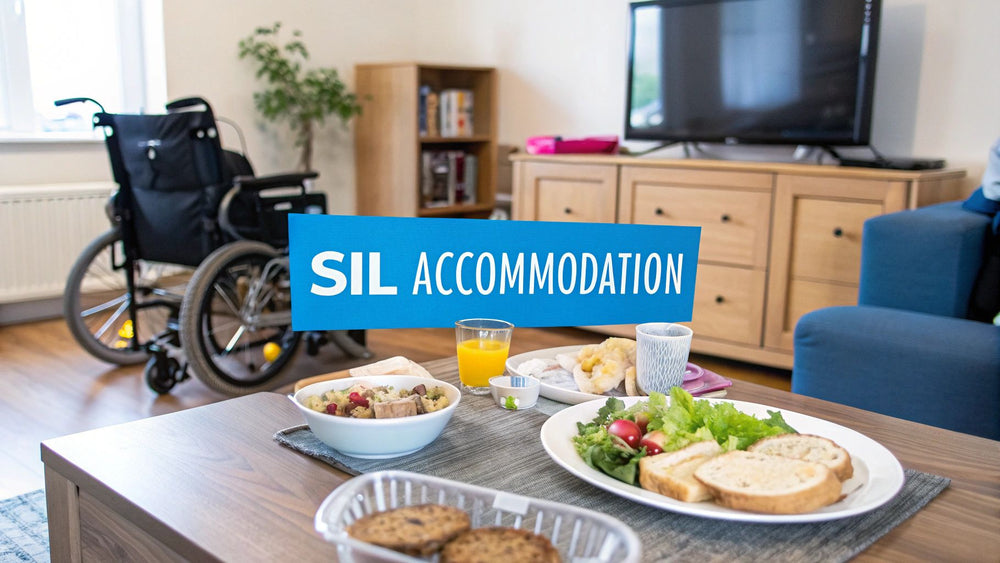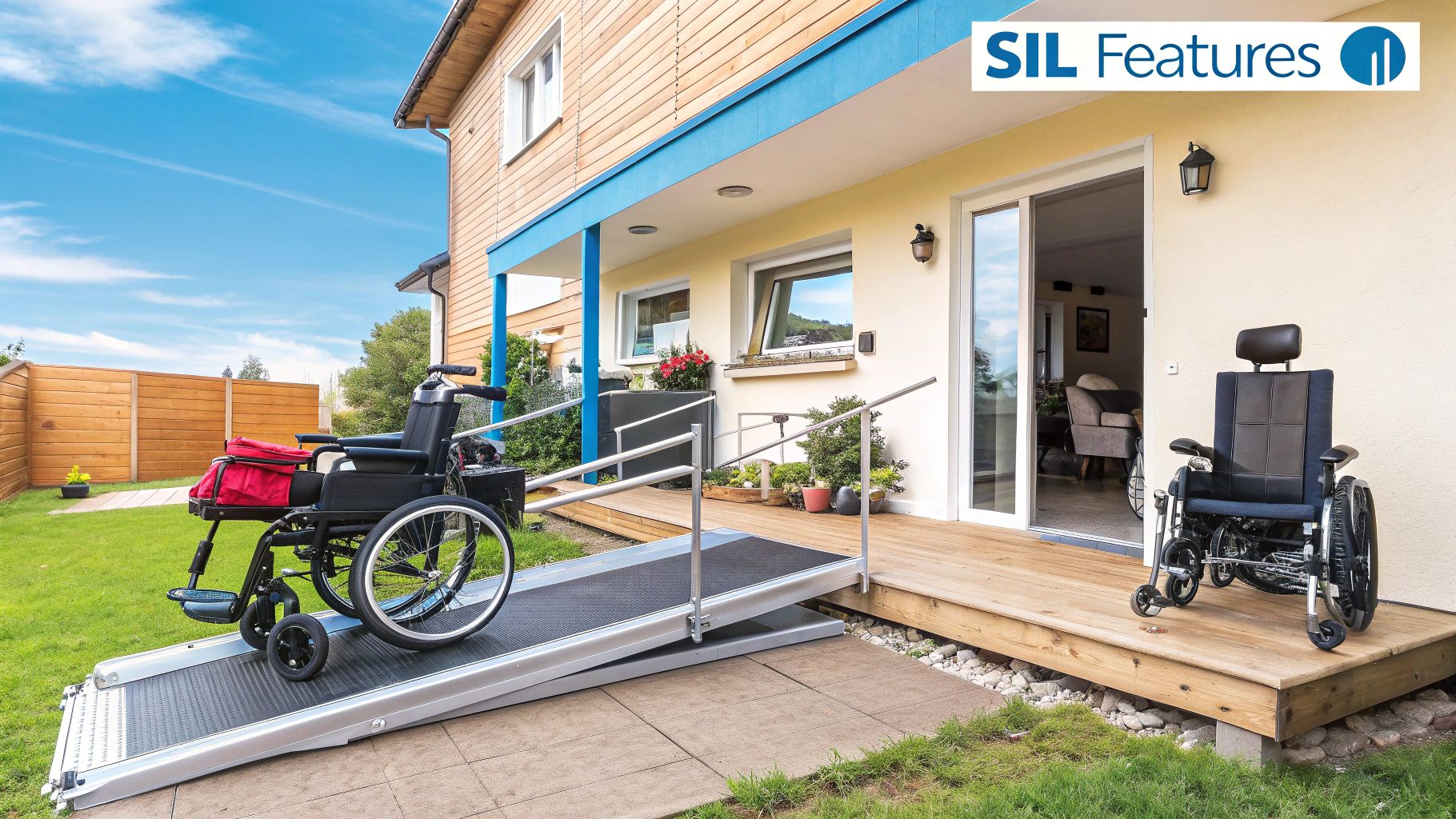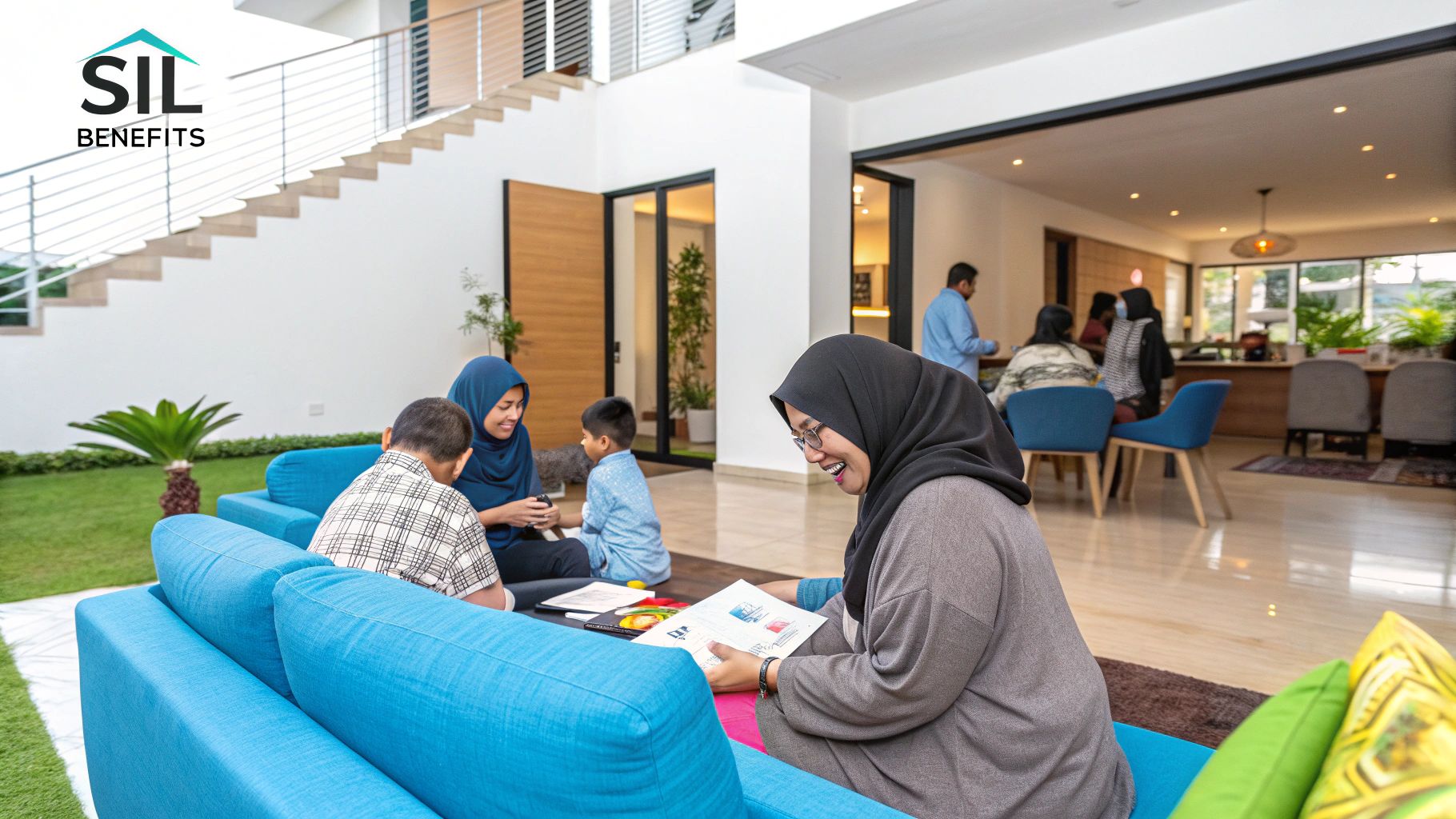What Is SIL Accommodation? Complete Guide for NDIS Participants

At its heart, Supported Independent Living (SIL) is an NDIS support that covers the cost of the people who help you at home. It’s all about getting the hands-on assistance you need to live as independently as possible, right where you are.
This isn't funding for the physical building itself. Instead, it’s about the support staff who can help you with daily life.
What Does SIL Look Like in Practice?
Think of SIL less like paying rent and more like having a dedicated support team to help you navigate your day. It’s specifically for NDIS participants who have higher support needs and want to build their skills for greater independence.
This funding is entirely separate from other costs like your rent, mortgage payments, or day-to-day expenses such as groceries and utility bills. It’s purely for the support you receive.
A common point of confusion is the difference between SIL and Specialist Disability Accommodation (SDA). They often work together, but they fund completely different things.
SIL vs SDA: Understanding The Key Differences
Here’s a simple table to break down the distinction between these two critical NDIS supports.
| Aspect | Supported Independent Living (SIL) | Specialist Disability Accommodation (SDA) |
|---|---|---|
| What It Funds | The people and support services (e.g., personal care, meal prep, skill-building). | The physical building itself (the bricks and mortar of a specially designed home). |
| Primary Goal | To help you live more independently and build skills in your own home. | To provide a home that is physically safe, accessible, and meets your needs. |
Essentially, SIL pays for your support workers, while SDA pays for the specialised house you live in. You can have one without the other, but many people with complex needs will have funding for both in their NDIS plan.

As you can see, the process is centred around you. Your unique needs determine the right support services, which in turn helps you achieve your goals for independence.
If you’d like to dive deeper, our guide on what SIL stands for in the NDIS has more detail.
The True Purpose of Supported Independent Living

We've covered the technical side of SIL accommodation, but its real value runs much deeper than a list of funded tasks. At its heart, SIL is about building a life you love, not just running a household. The true goal is to create a supportive environment where genuine independence, confidence, and connection to your community can really take root and grow.
Think of it like learning to ride a bike. At first, you have training wheels to give you stability and prevent you from falling. SIL supports are those training wheels. They provide the safety and assistance you need to practise, build your skills, and eventually ride on your own.
This means we need to look beyond clinical terms and focus on what it looks like in real life. It’s about:
- Feeling the pride of managing your own budget for the first time.
- Gaining the confidence to invite friends over for a dinner you’ve planned and cooked yourself.
- Mastering a new recipe or navigating the grocery store with ease.
These are the moments where the idea of what is SIL accommodation becomes a reality. It’s how the NDIS principles of choice and control stop being just words on paper and become part of your everyday experience.
Fostering Independence And Skill Building
The whole point of SIL is to empower you, not to do things for you. A support worker might start by helping you with meal prep, but the long-term goal is always to work with you, teaching you the skills to eventually make your favourite meal all by yourself.
This “teach, don’t just do” approach is fundamental. It's a philosophy that's making a real difference. In 2021, around 25,954 adults across Australia were using SIL supports, which shows a major commitment to helping people with disabilities build their independent living skills. You can dive into the data yourself by checking out the NDIS Commission's research findings.
Supported Independent Living is one of the most powerful tools in the NDIS for turning goals into daily realities. It provides the consistent, reliable support needed to practice new skills, build confidence, and ultimately take greater control of your own life.
By focusing on building your capabilities, SIL can help reduce the need for high-level assistance over time. For a closer look at the nuts and bolts, our detailed article on what is Supported Independent Living breaks down how it's all put together.
Here's the rewritten section, crafted to sound more human and expert-driven, while retaining all the core information.
How SIL Funding Fits Into Your NDIS Plan
Figuring out how funding works for Supported Independent Living (SIL) can feel a bit different from other NDIS supports, and that’s a crucial thing to understand right from the start. You won't see a specific dollar amount for SIL magically appear in your plan. Instead, your plan will show that you have approval for SIL, with the final funding figure worked out later with the provider you choose.
A good way to think about it is like getting pre-approval for a home loan. The bank gives you the green light in principle, but the exact loan amount isn't finalised until you've found the house you want to buy. It's the same with SIL – the approval is there, but the funding is tailored to the specific roster of care you and your housemates actually need. This makes sure the support is a perfect fit for your day-to-day life.
Your SIL funding is allocated under your Core Supports budget. It’s really important to know that this money is exclusively for the support workers—the people helping you out—and nothing else. It's kept completely separate from your other living expenses and won't cover things like:
- Rent or your mortgage
- Everyday bills like electricity, gas, or water
- Groceries and other household supplies
These are just the normal costs of running a home, which you'll need to cover with other income, such as the Disability Support Pension (DSP).
Building Your Case For SIL Funding
To get the NDIA to approve SIL, you need to show them solid evidence that it’s a reasonable and necessary support for you. It’s not enough to simply say you need help; you have to build a compelling case that clearly shows why this type of support is the right fit.
The single most important document you'll need is a Functional Capacity Assessment (FCA). This is a comprehensive report put together by an allied health professional, usually an Occupational Therapist (OT), that dives deep into your abilities and the exact support you need to manage daily life and work towards your goals.
Think of a strong FCA as your roadmap. It needs to clearly map out your daily challenges, pinpoint the specific supports required to meet them, and explain how SIL is the key to unlocking greater independence for you. This document is truly the foundation of a successful SIL application.
Once you have that approval in your plan, you, your chosen SIL provider, and your Support Coordinator will collaborate on a detailed quote. This is often called a Roster of Care, and it’s basically a schedule that breaks down all the support hours for everyone living in the home. It ensures the right staff are on deck at the right times, day and night. This quote is then sent to the NDIA to get the final funding locked in, making the whole process much more straightforward.
Determining Your Eligibility For SIL Supports

So, how do you know if SIL is the right fit for you or someone you care for? Figuring out if you're eligible is the first crucial step. Broadly speaking, SIL is designed for NDIS participants who are over 18 and need a significant amount of help to live more independently.
This doesn't mean you can’t do things for yourself. It’s more about acknowledging that you have substantial, ongoing needs that require reliable assistance, often around the clock, from dedicated support workers.
The NDIA will need to see clear evidence that SIL is a ‘reasonable and necessary’ support. This isn't just a box-ticking exercise; it's about painting a clear picture of why this level of help is essential for you. For a deeper dive into how this funding connects with the physical housing, check out our guide comparing SDA vs SIL funding.
What Does Significant Support Look Like?
Let's get practical. What kind of real-world situations suggest that SIL could be a great option? It’s for people who need consistent, reliable help with various daily activities.
SIL is for people who need more than just a few hours of drop-in support. It's about having a team available around the clock to ensure safety, help build skills, and provide assistance with personal and household tasks.
This often includes individuals who need:
- Substantial Personal Care: Hands-on assistance with daily routines like showering, dressing, or personal hygiene.
- Complex Health Management: Regular help with managing medications, monitoring health conditions, or carrying out specific health procedures.
- Mobility and Transfer Support: Consistent support from another person to move safely around the home, or to get in and out of bed or a chair.
- Behavioural Support: A dedicated team to help manage complex behaviours and create a safe, stable living environment.
If these scenarios resonate with your own situation, then exploring SIL accommodation is likely a very worthwhile next step on your NDIS journey.
Why the Need for SIL Is Growing in Australia
To really get a handle on Supported Independent Living, it helps to zoom out and look at the bigger picture of disability housing and support across Australia. The simple truth is that the demand for SIL is climbing, and that's creating a pretty challenging situation for NDIS participants and their families.
I don't say this to worry you, but to give you a clear-eyed view of the landscape. When you understand this dynamic of supply and demand, you can plan much more effectively and navigate the system with a solid strategy. Two major forces are behind this increasing need.
Key Drivers of Demand
First, we're seeing a rise in the number of NDIS participants who require high-level, complex support. At the same time, a major demographic shift is happening. Many ageing parents and family carers, especially from the Baby Boomer generation, are finding it more difficult to provide the same level of care for their adult children as they once did.
This has opened up a significant gap between the support people need and what's actually available.
As of late 2023, Australia had over 3,300 registered group homes providing a place for 14,000 residents. But demand is still running well ahead of supply. The NDIS found that 3,500 more people required SIL funding in 2022-23 than they had forecasted, bringing the total number of people needing this support to around 34,000.
Projections suggest this number could soar to over 50,000 by 2033, which really underscores the urgency. If you want to dig into the numbers yourself, the Grattan Institute’s full report on NDIS housing reform offers a detailed breakdown.
Getting through this environment is all about being proactive, and having a sense of the future of disability care can put you a step ahead.
How To Choose The Right SIL Provider For You

Choosing your SIL provider is one of the most significant decisions you’ll make on your NDIS journey. This isn’t just about finding a service; it's about building a partnership that will shape your daily life, your happiness, and your ability to chase down your goals. Think of it less like renting a room and more like finding the right teammates for your life.
The right provider will focus on you from the very first conversation. They'll want to know who you are and what you want to achieve. A really important thing to check is how they handle the realities of shared living. Ask them straight up about their process for matching housemates and what they do when disagreements pop up. A good answer here is a great sign that they know how to create a positive and supportive home.
Questions To Ask A Potential Provider
When you start meeting with providers, it’s a great idea to have some questions ready to go. This puts you in the driver's seat and helps you make a choice that feels right for you.
Here are a few to get you started:
- Person-Centred Care: "How do you make sure your support is built around my goals, not just a one-size-fits-all service?"
- Staff Expertise: "What specific training do your support workers have that relates to my needs?"
- Housemate Matching: "Can you walk me through your process for finding compatible housemates, and how much say do I get in that decision?"
- Community Connection: "How will you support me to get out and about, connect with my local community, and do the things I love?"
It’s also important to get a clear picture of the housing situation itself. Your SIL funding covers the support you receive, but the actual house often falls under a different category called Specialist Disability Accommodation (SDA). While the NDIS created SDA to give people more housing options, there's a serious shortage. For instance, in August 2021, around 12,700 people had SDA funding, but there were only about 2,000 certified homes available.
Remember, the NDIS principle of 'choice and control' isn't just a catchphrase—it's your right. The best providers live by this, working with you to build a genuine partnership. To see what this looks like in practice, you can explore our guide on understanding Vana Care's SIL services in SA.
Still Have Questions? Let's Clear Things Up
When you're first exploring Supported Independent Living, it's completely normal to have a lot of questions. Getting the right answers can make all the difference, so let's break down a few of the most common things people ask about SIL accommodation.
Does SIL funding cover my rent and bills?
This is probably the biggest point of confusion, and the short answer is no. It’s a crucial distinction to make.
SIL funding is specifically for the support services you need—the hands-on help from trained staff. It doesn't cover everyday living costs like rent, electricity, or your weekly grocery shop. Those are separate expenses that you'll cover with your own income, like the Disability Support Pension (DSP).
Do I get to choose who I live with?
Absolutely. You should have the final say on who shares your home. Any quality provider will have a thoughtful process for matching housemates, aiming to create a supportive and harmonious living space. You should always be part of the conversation when a new person is considering moving in.
What happens if I'm not happy with my provider?
This is your life and your choice. You are never stuck. Your NDIS funding is attached to you, not the provider. If the support you're receiving isn't a good fit or isn't helping you reach your goals, you have every right to find a new provider who better understands you.
Finding the right SIL provider is more than just finding a house; it's about building a partnership. At Vana Care, we focus on creating support that reflects your personality, passions, and goals, empowering you to live a life full of independence and joy. Start the conversation with us today.


